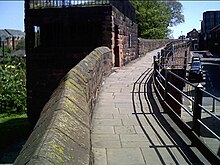Chester city walls surround the medieval extent of Chester. The circuit of the walls extends for 2 miles (3 km), rises to a height of 40 feet (12.2 m), and "is the most complete circuit of Roman and medieval defensive town wall in Britain." The walls and associated structures are a scheduled monument, and almost all parts are listed, mainly at grade I.
The walls originated between 70 and 90 AD as defences for the Roman fortress of Deva Victrix. The earliest walls were earth ramparts surmounted by wooden palisades, with wooden gates and towers. Rebuilding in sandstone started at the end of the 1st century and took over 100 years. The existing circuit was completed by the end of the 12th century. The four main gates were replaced during the 18th and early 19th centuries.
By the 18th century the walls were becoming popular as a promenade, and £1,000 (equivalent to £210,000 in 2023) was spent in 1707 on repairs and paving the footway. Distinguished visitors who walked the walls at that time included John Wesley and Samuel Johnson. They remain a significant tourist attraction.
